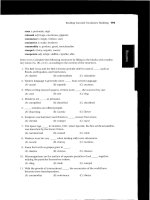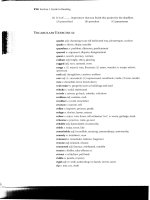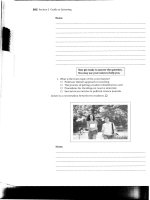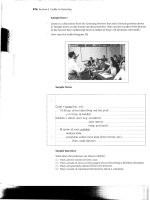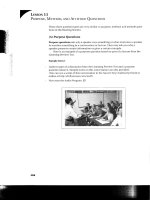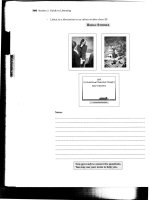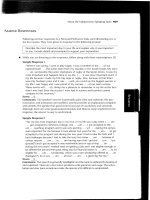Complete Guide to the Nikon D200- P1 pps
Bạn đang xem bản rút gọn của tài liệu. Xem và tải ngay bản đầy đủ của tài liệu tại đây (480.45 KB, 30 trang )
V1.03
Thom Hogan’s Complete Guide to the Nikon D200 Page 1
Thom Hogan’s
Complete Guide
to the Nikon D200
1
st
Edition
By Thom Hogan
byThom Press
V1.03
Thom Hogan’s Complete Guide to the Nikon D200 Page 2
Thom Hogan’s Complete Guide to the Nikon D200
First Edition 2006
Published in the United States by
byThom Press
Emmaus, PA 18049
H
© 2006 Thom Hogan
All Rights Reserved
Copies of this work may not be distributed in any form or by
any transmission method.
All photographs by and © Thom Hogan
This book is not sponsored by Nikon Corporation.
Information, data, and procedures described herein are
correct to the best of the author’s and publisher’s knowledge;
all other liability is expressly disclaimed. Nikkor, Nikon, and
Speedlight are registered trademarks of Nikon Corporation,
Japan. CompactFlash is a trademark of SanDisk Corporation.
All other products or name brands are trademarks of their
respective manufacturers.
The author and publisher shall not be responsible for errors
contained herein or any damages in connection with the
furnishing, performance, or use of the material in this book. In
particular, the author and publisher shall not be responsible
for any damage to the sensor of the camera of any reader who
follows the cleaning instructions contained in this book. Nor
shall the author and publisher be responsible for damage to
camera electronics by anyone attempting to make their own
external power supply based upon the ideas presented in this
book. It’s a sad commentary on our society that I even need to
include this disclaimer.
1
st
Edition, version 1.03: 4/5/06
V1.03
Thom Hogan’s Complete Guide to the Nikon D200 Page 3
Acknowledgements
As with all my books, a full draft was reviewed by volunteers
to weed out unclear language and misstatements. This book is
better because of them.
Several Web sites proved useful in researching aspects of this
book. While I mention several at appropriate points in the
book, four need to be singled out for D200 users:
• Phil Askey’s
H not only has some
of the most thorough reviews of digital cameras (yes, even
more thorough than the ones on my own site), but also
has an ongoing forum that’s useful for getting answers to
tough questions (select Nikon D100/D1/D2/D200 from the
Forums pop-up in the left navigation panel).
• Rob Galbraith
H has
developed a reputation in the digital photojournalism
world for some of the most articulate and detailed
explanations of professional digital camera use. Again, an
active forum helps get answers to common problems
(select Forums in upper left navigation panel and then
the Nikon Digital SLR link in the forums).
• Nikonians
H is another of the
“well-attended” public forums that are useful for Nikon
D200 users. Click on Forums, register as a member or
click on CLICK HERE to go to Forums, then click on
the D200 Users Group link.
• Nikon Café
H is a relatively new
moderated forum and has had a lively discussion of the
D200. Click on Cameras and Gear, then click on the
Nikon D200 forum link.
V1.03
Thom Hogan’s Complete Guide to the Nikon D200 Page 4
About this eBook
This eBook was created using Adobe Acrobat directly from
my original files. I’ve tried to retain as many of the
navigational features as Acrobat allows (for example, the
Bookmarks section at the left is derived from the Table of
Contents and is fully active—click on an entry and you’ll be
taken to it). Curiously, trying to create a fully functional eBook
using Adobe’s tools is worthy of an eBook itself (most of the
chapters would be centered on trying to get promised features
to work, and how they keep changing between Acrobat
Professional versions, sometimes going backwards in ability).
Your Rights versus Mine
I make my living documenting Nikon equipment. Thus, I have
registered the Copyright for this work in order to protect my
rights.
That said, I have not enabled copy protection, forced you to
enter a serial number, asked you to agree to a License
Agreement, or in any other way limited access to the
information in this eBook. I trust you to honor my Copyright
and to follow a few simple guidelines:
1. Treat the CD you received as you would a printed
book.
2. I grant those of you who purchased this eBook directly
from Thom Hogan the specific permission to print or
have printed by a third party a single copy of this
eBook for your own private use. You may not resell
that printed copy, and must destroy it if you sell or
pass on the original eBook you received to someone
else. Do not print a copy if you don’t agree with the
previous sentence.
3. I grant everyone who purchases the eBook directly
from Thom Hogan specific permission to create a
backup copy of this eBook file for their own private
use. However, you must destroy that backup copy and
V1.03
Thom Hogan’s Complete Guide to the Nikon D200 Page 5
any other copies you have of this work, printed or
electronic, if you sell or pass on the original eBook
you received.
It is a violation of Copyright law to sell copies of this work. It
is also a violation of Copyright law to put this work in any
public forum, send it to any newsgroup, place it on a Web
site, or allow it to be accessed on any file sharing service.
This work is registered with the Copyright office. That means
that punitive damages and legal fees can and will be sought
against anyone found illegally copying this work. Ignorance of
the law and claims that someone else told you that you had
rights to resell this work
F
1
are not legal defenses.
1
I have not and will not pass rights for this work to other parties. Yes, other people
fraudulently claim that they own the rights when they don’t. And they hear from my
lawyer when they do. Don’t say you weren’t warned should you try this.
V1.03
Thom Hogan’s Complete Guide to the Nikon D200 Page 6
Printing the eBook
On to more a more positive subject: if you’d like a hard copy
of the eBook, you can print a copy for your personal use by
selecting PRINT from the FILE menu.
It’s possible to print on both sides of the paper and get a real
book-like experience by using the Print: Odd Pages Only
and Print: Even Pages Only options on the Print dialog, but
I don’t recommend this unless you’re good at keeping track of
paper, know how to properly re-orient the paper for the
second pass, and are sure that your printer won’t choke on a
page somewhere.
Since there are so many printers available and their dialog
boxes all allow different printing options, I can’t help you
figure out the most economical or convenient way to print
your eBook
F
2
. Yes, it even took me a few minutes to figure out
how to create front and back copies on my laser printer, so I
know it’s a hassle. A complete set of step-by-step instructions
that work for the three printers I have available are included
on the CD in a separate file, called
PRINTING.PDF.
Take the resulting pages to your copy shop, have them trim
the edges (the final page size is 5.5 x 8.5” unless you’ve let
Acrobat rescale the book to fit the full page) and bind. This
eBook is actually in three specific sections that could be
bound separately (“Before You Take Pictures,” “Shooting
Pictures with Your D200,” and “After You’ve Taken Pictures
with your D200”); I’ve tried to keep the instructions you’d
want while out shooting in the middle section.
2
Since I get the occasional question as to why I don’t publish a paper version, I’ll
explain: paper versions turn out to be more expensive to produce in the small
quantities at which a niche publication like this sells. Producing this eBook
electronically allows me to create it on demand, reducing waste and cost, and to
keep it up to date as I learn new things about the camera. It also gives me a chance to
correct the inevitable minor typos that somehow creep into every major production.
On that last point: I keep a current errata list on my Web site. You’ll find the one for
this version of the eBook (1.03) at />.
V1.03
Thom Hogan’s Complete Guide to the Nikon D200 Page 7
If you’re really the type that doesn’t like to struggle through
the paper handling idiosyncrasies of your printer, most
Kinko’s and similar copy shops can print, collate, and bind a
nice portable version of this book for you (show them the
statement on the back cover or on the previous page if they
balk at printing a Copyrighted work). Make sure they know
that the final page size is 5.5” x 8.5”.
Note: Kinko’s and other copy shops should actually refuse to
make a copy of this eBook, as it is protected by Copyright.
Show them the boxed area on the back cover of the eBook
jacket, my Web page for the eBook, or Item #2 in the “Your
Rights versus Mine” section where I grant you permission to
print or have printed a copy for your personal use. If that
doesn’t work, have them email me at
to verify that this is okay.
If you encounter a copy shop that doesn’t ask you to show
permission to reproduce a copyrighted work, or one that
still refuses after being shown permission, I’d like to hear
about it. If the former and the copy shop is a chain, it is
probably violating direct court orders that mandate that
they don’t do this. I’ve not put Digital Rights Management
on this file to block all copying and printing, because it’s a
hassle for the user. So, please respect my rights and help
report those that willingly violate them.
Note: Some Kinko’s now use a special piece of software to print
from PDF files, such as the one for this eBook. Since that
software first attempts to extract all text from the file and I
have selected to block text extraction in Acrobat, this means
that such software fails to work with this eBook. Kinko’s can
still print it by simply running Acrobat, but this limits some
of the fancier options they can do.
This eBook is designed to help you get quality results from
your Nikon D200. While I’ll try to provide introductory
material that should help even a photography novice get by,
this eBook probably isn’t the place to learn what an aperture
or shutter speed is (check out
H if you want some
recommendations for general photography books).
V1.03
Thom Hogan’s Complete Guide to the Nikon D200 Page 8
Nevertheless, I will try to explain the concepts and
terminology that are necessary to understand how a D200
works. If you find something in this eBook unclear, or that I’ve
assumed knowledge on your part that you don’t have, don’t
hesitate to drop me an email asking for an explanation. Not
only will I answer your question, but it will give me some
insight on what I might want to change in future editions to
make the eBook even clearer.
Besides dealing with the practical side of the camera and
showing you how all the basic functions work, I’ll also
provide you with some tips on how to squeeze every last bit
of image quality out of your camera as well as how to make
up for some of its shortcomings.
V1.03
Thom Hogan’s Complete Guide to the Nikon D200 Page 9
Note on the First Edition
While this is a first edition, the D200 is enough like earlier
Nikon DSLRs that I’ve been able to re-purpose and rewrite
portions of earlier eBooks—specifically the D2x eBook, as the
D200 shares menu structure and many options with that
camera—which means that much of the information here has
been previously vetted.
One thing I have done with this eBook, though, is restructure
it from my previous ones, and augment it with more
introductory material. The audience for the D200 includes
more first-time SLR
F
3
users, so I’ve worked very hard on
making this work both more approachable and more
understandable, even though my previous Nikon books have
been highly regarded in that respect.
Since I mentioned the change in structure, let me point it out;
this eBook is separated into three distinct sections:
• Things you should know and consider before using the
D200 (labeled “Before You Take Pictures” and starts on
page <
H29>). In this first major section I cover a lot about
what a DSLR is, some of its critical components (like the
sensor that captures images), how to set up your camera
for shooting, and things you should do and know before
you head out the door to take pictures. This section is up
front because it’s the background material you need to get
up to speed with the unique aspects of your camera.
• Things you need to know while using the D200 (labeled
“Shooting Pictures with the D200” and starts on page
<
H209>). This is the “how-to” section of the eBook. Here’s
where I walk you through each feature of the camera as
you’d use it. I’ll explain why you might use it, how to
make that feature active, and what your options are. If
you’re going to print only one section of this eBook and
3
SLR stands for Single Lens Reflex, and I’ll explain what that means on page <29>.
You’ll also see me use DSLR, or Digital Single Lens Reflex, to distinguish the digital
bodies from the film bodies.
V1.03
Thom Hogan’s Complete Guide to the Nikon D200 Page 10
carry it with your camera, this is the section you’ll want.
Yes, you may find a few things repeated in this section
from the first, but in the interest of making for a complete
“how-to” section, I’ve elected to repeat some set-up and
other instructions.
• Things you need to know and do after you’ve taken your
pictures (labeled “After You’ve Taken Pictures with Your
D200” and starts on page <
H588>). When you come back
from shooting with your camera you still have things you
may want to do, like transfer, print, view, organize, or
improve your images. This is where Nikon’s supplied
software comes in, and you’ll be at your computer for
most of this type of work, so we’ll be discussing
computers and computer hookups here.
That also mimics the order you’ll want to follow as you
master your new camera: initiation, use, and post production.
As I wrote earlier, this eBook incorporates a few bits and
pieces from earlier eBooks I’ve written about Nikon
equipment. It’s not easy keeping up with all the changes
Nikon keeps making to its DSLR lineup and software, though,
so if you have any of my previous eBooks you’ll find that my
words and explanations may have changed, even for features
that were common across many models. So don’t skip over
anything—read everything here as it stands, not as you think it
might be.
As I receive comments from readers of this eBook, I update
the original file. Since I generate this eBook directly from my
files, this means that I am usually able to keep the text nearly
error-free while adding or modifying sections to make a point
more clearly. Every now and then I make a full pass through
the manuscript, augmenting what I’ve previously written with
knowledge I’ve learned from using the camera, teaching
workshops, and from other sources. When I do that, I iterate
the “edition number.” And when I create a new edition, I offer
low-cost updates to people that bought the original eBook
from me.
V1.03
Thom Hogan’s Complete Guide to the Nikon D200 Page 11
So, if you do find an error or confusing wording, take a look
at
H to make sure
that the problem hasn’t already been discovered; drop me an
email telling me about it if it hasn’t.
V1.03
Thom Hogan’s Complete Guide to the Nikon D200 Page 12
Table of Contents
ACKNOWLEDGEMENTS H3
ABOUT THIS EBOOK H4
YOUR RIGHTS VERSUS MINE H4
PRINTING THE EBOOK H6
NOTE ON THE FIRST EDITION H9
TABLE OF CONTENTS H12
CONVENTIONS USED IN THIS EBOOK H22
INTRODUCTION H24
BEFORE YOU TAKE PICTURES H29
WHAT’S AN SLR? H29
PHOTOGRAPHIC TERMS THAT ARE IMPORTANT TO KNOW H39
THE D200’S HISTORY H42
AN ASIDE ABOUT LENSES H44
BACK TO THE D200 BODY H47
BUT WHAT ABOUT FILM? H48
DEBUNKING SOME MYTHS H53
D200 BASICS H60
D200 Design H60
The D200’s Sensor H66
Sensor Specifications (Size) H68
Sensor Specifications (Pixels) H69
Sensor Filtration H70
Tonal Range H76
Brightness v. Darkness H78
Spectral Characteristics H80
Noise H80
Sensors and Light Alignment H88
Sensor Longevity H89
Sensor Wrap-up H90
POWER H91
Changing Batteries H94
Charging Batteries H95
Battery Storage H96
Clock Battery H97
Alternate Power Sources H97
Battery Life H102
Battery Notes H108
IMAGE STORAGE H109
Buffer Sizes H112
CompactFlash H113
Solid-State CompactFlash H114
Microdrives H116
V1.03
Thom Hogan’s Complete Guide to the Nikon D200 Page 13
Microdrive Compatibility H117
Using CompactFlash H119
Nikon-Approved Cards H122
How Much Card? H123
CompactFlash Troubleshooting H124
Image Formats H127
Pixels H129
JPEG H131
Setting JPEG H134
JPEG Rendering H139
JPEG Artifacts H140
NEF Format H145
D200 File Sizes H148
Compressed NEFs H149
Why NEF? H150
The NEF White Balance Controversy H152
Setting NEF H155
Setting Compressed NEF H157
EXIF H159
IPTC H161
DPOF and PictBridge H162
File Names and Folders H163
Folders H163
File Names H169
File Numbering Sequence H176
CAMERA SETUP H178
How Menus Work H178
The SET UP MENU H181
Date, Time, and Language H183
Setting Date and Time H184
Setting Language H188
Programming a Comment H189
Setting the LCD Brightness H191
Setting the File Numbering Sequence H193
Set Up Recommendations Summary H195
Image Quality H196
Approximate Images Per Card H197
Viewfinder Adjustment H200
Focus Screens H201
Resetting the Camera H202
Resetting Basic Settings H202
Settings after Reset H202
Resetting Other Settings H203
Resetting Custom Settings H204
The Last Resort Reset H204
Firmware Version H205
SHOOTING PICTURES WITH THE D200 H209
CAMERA AND SHOOTING CONTROLS H209
D200 Controls H209
V1.03
Thom Hogan’s Complete Guide to the Nikon D200 Page 14
Front View H210
Top View H211
Back View H212
Side View H213
D200 Displays H214
D200 Top LCD H214
D200 Color LCD H216
D200 Viewfinder H217
METERING AND EXPOSURE H219
Metering Methods H220
Matrix H220
Center-weighted H224
Spot H225
Spot Meter Point H227
Metering Compatibility H227
Setting the Metering Method H227
So Which Metering System Should You Use? H228
Metering with Digital Requires Care H229
Options for Evaluating Exposure H233
How to Interpret Histograms H237
Exposure Modes H243
Flexible Program H245
Program Exposure Table (at ISO 100) H246
ISO Sensitivity H247
Noise Reduction Settings H255
Auto ISO H258
How ISO Values are Created H260
ISO Operating Suggestions H260
Exposure Bracketing H263
D200 Exposure Bracketing Values Table (Exposures) H264
Exposure Compensation H270
White Balance H272
D200 White Balance Settings H280
D200 White Balance Bracketing Values Table H289
Changing Color Characteristics H290
Tone Compensation H293
Hue H296
Saturation H298
Color Space and Color Mode H299
Setting Tone, Hue, Saturation, and Color Mode H301
LENSES AND FOCUSING H303
Focal Length Limitations H306
Lens Differences When Used for 35mm film and D200 H309
Lens Angle of View H310
Lens Compatibility H312
The Autofocus System H315
Focus Mode (Single Servo, Continuous Servo, and Manual) H319
Single Servo versus Continuous Servo Autofocus H320
V1.03
Thom Hogan’s Complete Guide to the Nikon D200 Page 15
Autofocus Area Modes H322
Autofocus Summary H324
Autofocus Settings Summary H324
Trap Autofocus H325
Autofocus Assist H326
Lock-On (Focus Tracking) H327
Manual Focus H327
Sharpening H328
SHOOTING CONTROLS H337
Shutter Releases H337
Shutter Lag H338
Frame Advance H340
D200 Maximum Buffer Capacity H342
Frame Advance Troubleshooting H342
Self Timer H343
Interval Shooting H345
Multiple Exposures and Overlays H351
Remote Control H358
Connecting to a GPS H358
Depth of Field Preview H360
18mm Lens H362
20mm Lens H362
24mm Lens H363
28mm Lens H363
35mm Lens H363
50mm Lens H364
70mm Lens H364
Diffraction H364
Other DOF Theories H365
D200 Menus H367
PLAYBACK menu (² tab) H368
SHOOTING menu (õ camera tab) H369
CSM (custom settings) menu ( pencil tab) H376
SET UP menu (Ø wrench icon) H377
Recent Settings menu (folder tab) H379
Error Messages H381
IMAGE REVIEW AND PLAYBACK H387
Image Review H387
Image Review Options H388
Rotating Images H395
The PLAYBACK Menu H397
Deleting Images H398
Dealing with Folders H400
Hiding Images H403
CUSTOM SETTINGS H406
Custom Setting #C Custom Settings Bank (Custom Settings
Bank)
H411
V1.03
Thom Hogan’s Complete Guide to the Nikon D200 Page 16
Custom Setting #R Custom Settings Reset (Reset Custom
Setting Menu)
H415
Custom Setting #A1 Continuous Servo AF Priority (AF-C
Priority Selection)
H418
Custom Setting #A2 Single Servo AF Priority (AF-S Priority
Selection)
H420
Custom Setting #A3 Focus Area Size (Focus Area Frame)H421
Custom Setting #A4 Group Autofocus Pattern (Pattern
Selection in Group Dynamic AF)
H423
Custom Setting #A5 Disable Focus Lock-On (Focus Tracking
with Lock-On)
H426
Custom Setting #A6 Initiating Autofocus (AF Activation) H428
Custom Setting #A7 Focus Area Illumination (AF Area
Illumination)
H429
Custom Setting #A8 Focus Area Selection Wrap (Focus Area
Selection)
H430
Custom Setting #A9 Autofocus Assist Illumination (Built-in AF-
Assist Illumination)
H430
Custom Setting #A10 MB-D200 AF-ON Button Options (AF-
ON Button for MB-D200 Battery Pack)
H431
Custom Setting #B1 Automatic ISO Setting (ISO Sensitivity
Auto Control)
H433
Custom Setting #B2 ISO Increment (ISO Sensitivity Step Value)
H436
Custom Setting #B3 Exposure Control Increment (EV Steps for
Exposure Control)
H437
Custom Setting #B4 Exposure Compensation Increment (Steps
for Exposure Comp and Fine Tuning)
H438
Custom Setting #B5 Exposure Compensation Control (Easy
Exposure Compensation)
H439
Custom Setting #B6 Center-weight Circle Size (Center-
Weighted Area)
H440
Custom Setting #B7 Meter Compensation (Fine Tune Optimal
Exposure)
H442
Custom Setting #C1 AE Lock Behavior (AE Lock Buttons)H443
Custom Setting #C2 AE-Lock Button Function (Assignment of
AE-L/AF-L Button)
H444
Custom Setting #C3 Meter/Camera Active Time (Meter-off
Delay)
H446
Custom Setting #C4 Self Timer Delay Setting (Self-Timer Delay)
H447
Custom Setting #C5 Color LCD Active Time (Monitor-off
Delay)
H448
Custom Setting #D1 Sound Feedback Setting (Beep) H449
V1.03
Thom Hogan’s Complete Guide to the Nikon D200 Page 17
Custom Setting #D2 Grid Line Display in Viewfinder
(Viewfinder Grid Display)
H449
Custom Setting #D3 Viewfinder Warnings Display (Viewfinder
Warning Display)
H450
Custom Setting #D4 Continuous Low Shooting Speed (CL-
Mode Shooting Speed)
H451
Custom Setting #D5 Shutter Delay (Exposure Delay Mode)H452
Custom Setting #D6 File Number Sequence (File Number
Sequence)
H453
Custom Setting #D7 LCD Illumination Control (LCD
Illumination)
H454
Custom Setting #D8 Battery Type in MB-D200 (MB-D200
Battery Type)
H455
Custom Setting #E1 Flash Top Sync Speed (Flash Sync Speed)
H456
Custom Setting #E2 Flash Shutter Speed Barrier (Slowest Speed
When Using Flash)
H457
Custom Setting #E3 Flash Mode for Internal Flash (Built-in Flash
Mode)
H458
Custom Setting #E4 DOF Preview Triggers Modeling Flash
(Preview Button Activates Modeling Flash)
H461
Custom Setting #E5 Exposure Bracketing Method (Auto
Bracketing Set)
H462
Custom Setting #E6 Manual Exposure Mode Bracketing (Auto
Bracketing in M Exposure Mode)
H464
Custom Setting #E7 Bracketing Order (Auto Bracketing Order)
H465
Custom Setting #E8 Bracketing Selection Control (Auto
Bracketing Selection Method)
H466
Custom Setting #F1 Direction Pad Center Button (Multi
Selector Center Button)
H467
Custom Setting #F2 Additional Direction Pad Control (When
Multi Selector is Pressed)
H470
Custom Setting #F3 Direction Pad Scrolling during Playback
(Role of Multi Selector in Full-Frame Playback)
H471
Custom Setting #F4 FUNC Button Setting (Assign FUNC.
Button)
H471
Custom Setting #F5 Command Dial Functions (Command
dials)
H474
Custom Setting #F6 Pressing or Holding Buttons (Setting
Method for Buttons and Dials)
H477
Custom Setting #F7 Lock Camera with No CompactFlash
(Disable Shutter if No CF Card)
H478
USING FLASH H480
V1.03
Thom Hogan’s Complete Guide to the Nikon D200 Page 18
What Happens When Flash is Used H480
Flash Basics H481
Digital Flash Differences H482
More Hidden Flash “Gotchas” H485
Allowable Apertures in Program Mode H485
D200 Safe Flash Head Focal Length Settings H486
Flash Modes H486
i-TTL Balanced Fill-Flash H487
Standard TTL H489
High-Speed TTL (TTL FP) H489
Summary of i-TTL Flash Modes H490
Non-TTL Flash Modes H490
Setting Flash Options H494
Flash Option Interactions H496
Flash Exposure Compensation H496
Flash Features Available using a D200 with Speedlights H499
Controlled, Repeatable Flash Results H500
Third Party Flash Units H503
Studio Flash H504
D200 INTERNAL FLASH H504
Internal Flash Basics H506
To Set TTL on the Internal Flash H506
To Set Manual Flash H507
Internal Flash Guide Numbers (Feet) H509
Internal Flash Guide Numbers (Meters) H509
To Set Repeating Flash H509
Wireless Flash H511
EXTERNAL FLASH MODELS FOR THE D200 H521
SB-600 H521
Specifications H521
To Set TTL Flash H522
SB-600 Usable Apertures and Flash Range in TTL mode (Feet) H523
To Set Manual Flash H523
SB-600 Guide Numbers at ISO 100 (feet) H525
SB-600 Guide Numbers at ISO 100 (meters) H525
To Manually Set the Zoom Head H525
To Set Flash Exposure Compensation H526
To Set Red-Eye Reduction H526
SB-600 Notes H527
SB-800 H528
Specifications H528
To Set TTL Flash H529
SB-800 Usable Apertures and Flash Range in TTL mode (Feet) H531
To Set Auto Aperture Flash H531
To Set Manual Flash H532
To Set Repeating Flash H533
Maximum Number of Repeating Flashes at Each Power Setting H534
To Manually Set the Zoom Head H535
V1.03
Thom Hogan’s Complete Guide to the Nikon D200 Page 19
To Set the Distance Scale to Feet or Meters H536
To Set Flash Exposure Compensation H537
To Set Red-Eye Reduction H537
SB-800 Notes H538
Flash Troubleshooting H539
USING A D200 IN THE FIELD H541
The “Routine” H541
General Settings You Make Once H541
Things To Do Before You Head Out on a Shoot H541
Check Each Time You Turn the Camera ON H543
Settings You Change Rarely (and then only for a reason) H544
Settings You Change Often H545
Things To Do After Each Shooting Session H546
Keeping Track of Batteries H547
Maintaining Image Quality H549
Which Type of Photographer are You? H551
Dealing with JPEG H553
Custom Curves H554
Color Profiles, Color Spaces, and Color Modes H557
Setting Color Spaces and Color Modes in the Camera H562
Setting Color Spaces and Profiles in Your Software H564
Fine Tuning the Color H566
Special Lighting Issues H569
UV and Infrared H569
Ultraviolet H569
Infrared H570
Shooting Under Fluorescent Lighting H572
Other Field Shooting Issues H575
Keeping the sensor Clean H575
Toppling a Myth H581
Worst Case Scenario H581
Panoramas H582
Temperature Considerations H582
Humidity H583
White Balance Settings H584
White Balance Color Temperatures H585
AFTER YOU’VE TAKEN PICTURES WITH YOUR D200 H588
THINGS YOU DO AFTER THE SHOT IS TAKEN H588
TRANSFERRING YOUR IMAGES TO YOUR COMPUTER H589
Connecting to a Computer H590
PRINTING YOUR IMAGES H594
Selecting Images to Print H595
PictBridge Printing H597
Printing Resolution H601
Output on Commercial Printers H604
VIEWING YOUR IMAGES H605
Television Playback H606
V1.03
Thom Hogan’s Complete Guide to the Nikon D200 Page 20
Slide shows H608
DIGITAL WORKFLOW H609
D200-RELATED SOFTWARE H613
Nikon PictureProject H614
Nikon View H628
Nikon Capture H644
Controlling the Camera H645
Taking Pictures with Capture H646
Making Settings with Capture H649
Manipulating Images H655
Individual Palette Tools H662
One Image Processed by Capture H678
Photoshop NEF Filter H688
Other Useful Software H691
NEF Converters H692
Image Editors H696
Manipulating Levels and Curves H698
Catalog Programs H700
Other Manipulation Tools H707
PHOTOSHOP ACTIONS H710
EXCEL WORKBOOKS H711
A WORD ABOUT COMPUTERS H712
D200 ACCESSORIES H717
SPECIFICATIONS H721
GETTING SERVICE H724
QUESTIONS AND ANSWERS H729
V1.03
Thom Hogan’s Complete Guide to the Nikon D200 Page 21
V1.03
Thom Hogan’s Complete Guide to the Nikon D200 Page 22
Conventions Used in this eBook
In this eBook I occasionally make comparisons between the
D200 and previous Nikon models. In general, whenever this
eBook uses the term D1 or D1 series, I’m referring to the
entire D1 family (i.e. the D1, D1h, and D1x). The same is true
of the D2 family (D2h, D2hs, and D2x). Use of an individual
model name in the text indicates a model-specific feature or
characteristic. In tables, if there are differences between the
cameras, I’ve either added columns for each camera, or
separated the information into model-specific tables.
Why am I including some D1 and D2 information in this
eBook? Many readers own multiple DSLRs or have experience
with previous Nikon models. Moreover, many D200
purchasers followed the earlier camera developments but
held off buying one until Nikon came out with a camera that
was less expensive. The introduction of the D200 was what
they were waiting for, though the resulting camera is a bit
different than the earlier models they learned about. Finally, it
is just good form to know how your camera compares against
other Nikon DSLRs.
When software products are mentioned, including those that
Nikon supplies with the camera, I try to identify the version I
used for this eBook when I introduce the product, and note
any significant differences between versions that I think you
should be aware of. If I refer to a software program
generically, as in “use the Unsharp Mask in Photoshop,” this
usually applies to the entire range of Photoshop versions.
Specific instructions for software, as in “select Remove
Redeye in the JustDoIt menu,” are for the version current as
of the publication of this eBook. Also, you’ll note that I use a
different font to distinguish menu items or messages that
you’ll see on the computer or camera screens—this makes it
easier for you to differentiate what I’m writing about from
what you should be seeing on your equipment.
V1.03
Thom Hogan’s Complete Guide to the Nikon D200 Page 23
Instructions that apply to using the camera are marked starting
with a
õ. Anywhere you see that symbol, grab your D200
and follow along!
As I have with all my previous books and eBooks, I use my
Web site (
H to
report any corrections or clarifications of information or
instructions (you’ll also find some helpful product reviews and
general articles). Write me at
if you
have any questions or comments.
Thom Hogan
Emmaus, PA
V1.03
Thom Hogan’s Complete Guide to the Nikon D200 Page 24
Introduction
You’ve purchased a Nikon D200 camera and are looking for
help in getting the best possible pictures from it. Or perhaps
you’re considering purchasing a D200 and want to know how
it works and what it is capable of. Welcome. You’ve come to
the right place.
First a little background for the newcomers: I’ve been using
Nikon cameras most of my life and for the last dozen years
have spent much of my time creating articles, books, and a
Web site explaining the nuances of these cameras to others.
Successfully, I think (I hope you’ll agree by the time you finish
reading this work).
You probably fall into one of three categories:
1. You’ve never used an SLR
F
4
type of camera before.
Previously, you probably used either a 35mm or
digital point-and-shoot type of camera. Those all-
automatic, all-in-one cameras are small and
convenient, but tend to be somewhat slower to shoot
and limited in control.
You probably decided to try a D200 to get away from
one of those two traits: you’re hoping that the
autofocus is fast and accurate, that there’s no delay
between pressing the shutter release and the time the
picture is taken, and that you can buy accessories that
allow you to take pictures you can’t with your
compact camera.
I’ll cut to the chase: you’ll be happy with your D200
(though I’d be remiss to point out that a D50 or D70s
4
Again, SLR stands for Single Lens Reflex. That may not mean a lot to you yet; the key
point is that an SLR uses a mirror relay system (the “reflex” portion of the name) to let
you see exactly what the lens is zoomed and focused on. Yes, there used to be a TLR
(Twin Lens Reflex), which is a system where you look through one lens via a mirror
system, and a second lens is used for taking the picture. The old Rolleiflex and
Yashicamats are examples of a TLR.
V1.03
Thom Hogan’s Complete Guide to the Nikon D200 Page 25
might be all that you need—the D200 goes far beyond
the point-and-shoot capability and is more complex
than you may be looking for). But you’ve got a lot to
learn, as SLRs tend to be more complex and
sometimes require more decisions than do the
automatic point and shoots.
If you fall in this category, you’ll want to read this
entire eBook very carefully—there’s really no section
you can skip over.
2. You’ve used a film SLR before, but are just now
switching to a digital SLR (DSLR). You probably
picked the D200 because it was modest in price but
big in features and quality.
Your film SLR worked just fine, but you’re looking for
the advantages that digital brings: instant review, no
wait for developing and processing, no per-image
costs, and convenience for emailing and sharing
pictures. You’re probably a little worried about image
quality—is a digital SLR like the D200 as good as
35mm film?
Again good news awaits you: yes, you’ll get all the
conveniences you seek and give nothing up in image
quality.
If you fall into this category, you’ll probably be able
to skip over many of the early portions of this book
(or read them as a refresher). But make sure that you
start reading seriously with the section labeled
“Camera Setup” on page <
H178>.
3. You’ve used a digital SLR before, so the D200 is likely
a backup or second body for you. You may have
picked the D200 because it looks like it might be a
less expensive backup to a D2x. And you’d be right—
while a few features are missing and the AF is a
different, the image quality of the D200 basically



